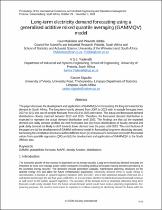 ResearchSpace
ResearchSpace
Long-term electricity demand forecasting using a generalised additive mixed quantile averaging (GAMMQV)
JavaScript is disabled for your browser. Some features of this site may not work without it.
- ResearchSpace
- →
- Research Publications/Outputs
- →
- Conference Publications
- →
- View Item
| dc.contributor.author |
Mokilane, Paul M

|
|
| dc.contributor.author |
Debba, Pravesh

|
|
| dc.contributor.author |
Yadavalli, VSS

|
|
| dc.contributor.author |
Sigauke, C

|
|
| dc.date.accessioned | 2019-03-29T10:11:56Z | |
| dc.date.available | 2019-03-29T10:11:56Z | |
| dc.date.issued | 2018-11 | |
| dc.identifier.citation | Mokilane, P.M. et al. 2018. Long-term electricity demand forecasting using a generalised additive mixed quantile averaging (GAMMQV). Proceedings of the International Conference on Industrial Engineering and Operations Management, Pretoria / Johannesburg, South Africa, October 29 – November 1, 2018, pp. 1618-1629 | en_US |
| dc.identifier.isbn | 978-1-5323-5947-7 | |
| dc.identifier.uri | http://ieomsociety.org/southafrica2018/proceedings/ | |
| dc.identifier.uri | http://ieomsociety.org/southafrica2018/papers/314.pdf | |
| dc.identifier.uri | http://hdl.handle.net/10204/10883 | |
| dc.description | Paper presented at the International Conference on Industrial Engineering and Operations Management, Pretoria / Johannesburg, South Africa, October 29 – November 1, 2018 | en_US |
| dc.description.abstract | The paper discusses the development and application of GAMMQV in forecasting the long-term electricity demand in South Africa. The long-term hourly demand from 2007 to 2023 with in-sample forecasts from 2007 to 2012 and out-of-sample forecasts from 2013 to 2023 were done. The actual and forecasted demand distributions closely matched between 2013 and 2015. Therefore, the forecasted demand distribution is expected to represent the actual demand distribution until 2023. The findings are that (a) the expected demand and daily demand profiles are well forecasted and (b) future distributions of hourly demand and peak daily demand are likely to shift towards lower demand over the years until 2023. The contributions of the paper are (a) the development of GAMM with trend model in forecasting long-term electricity demand, harnessing the correlation structures within different hours (c) inclusion of a nonlinear trend with forecasted values from quantile regression (QR) and (d) the development and application of GAMMQV to the South African data. | en_US |
| dc.language.iso | en | en_US |
| dc.publisher | IEOM Society International | en_US |
| dc.relation.ispartofseries | Worklist;21937 | |
| dc.subject | Density function | en_US |
| dc.subject | Distributions | en_US |
| dc.subject | Generalised additive mixed model | en_US |
| dc.subject | GAMM | en_US |
| dc.subject | Mean absolute percentage errors | en_US |
| dc.subject | MAPE | en_US |
| dc.subject | Probabilistic forecasts | en_US |
| dc.title | Long-term electricity demand forecasting using a generalised additive mixed quantile averaging (GAMMQV) | en_US |
| dc.type | Conference Presentation | en_US |
| dc.identifier.apacitation | Mokilane, P. M., Debba, P., Yadavalli, V., & Sigauke, C. (2018). Long-term electricity demand forecasting using a generalised additive mixed quantile averaging (GAMMQV). IEOM Society International. http://hdl.handle.net/10204/10883 | en_ZA |
| dc.identifier.chicagocitation | Mokilane, Paul M, Pravesh Debba, VSS Yadavalli, and C Sigauke. "Long-term electricity demand forecasting using a generalised additive mixed quantile averaging (GAMMQV)." (2018): http://hdl.handle.net/10204/10883 | en_ZA |
| dc.identifier.vancouvercitation | Mokilane PM, Debba P, Yadavalli V, Sigauke C, Long-term electricity demand forecasting using a generalised additive mixed quantile averaging (GAMMQV); IEOM Society International; 2018. http://hdl.handle.net/10204/10883 . | en_ZA |
| dc.identifier.ris | TY - Conference Presentation AU - Mokilane, Paul M AU - Debba, Pravesh AU - Yadavalli, VSS AU - Sigauke, C AB - The paper discusses the development and application of GAMMQV in forecasting the long-term electricity demand in South Africa. The long-term hourly demand from 2007 to 2023 with in-sample forecasts from 2007 to 2012 and out-of-sample forecasts from 2013 to 2023 were done. The actual and forecasted demand distributions closely matched between 2013 and 2015. Therefore, the forecasted demand distribution is expected to represent the actual demand distribution until 2023. The findings are that (a) the expected demand and daily demand profiles are well forecasted and (b) future distributions of hourly demand and peak daily demand are likely to shift towards lower demand over the years until 2023. The contributions of the paper are (a) the development of GAMM with trend model in forecasting long-term electricity demand, harnessing the correlation structures within different hours (c) inclusion of a nonlinear trend with forecasted values from quantile regression (QR) and (d) the development and application of GAMMQV to the South African data. DA - 2018-11 DB - ResearchSpace DP - CSIR KW - Density function KW - Distributions KW - Generalised additive mixed model KW - GAMM KW - Mean absolute percentage errors KW - MAPE KW - Probabilistic forecasts LK - https://researchspace.csir.co.za PY - 2018 SM - 978-1-5323-5947-7 T1 - Long-term electricity demand forecasting using a generalised additive mixed quantile averaging (GAMMQV) TI - Long-term electricity demand forecasting using a generalised additive mixed quantile averaging (GAMMQV) UR - http://hdl.handle.net/10204/10883 ER - | en_ZA |





